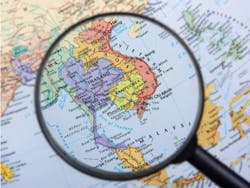CleanGrid Partners to Build a $100 Million Microgrid Portfolio in Southeast Asia
A new force emerged in the Southeast Asia microgrid market this week with the announcement by Singapore’s CleanGrid Partners that it plans to create a $100 million microgrid portfolio in the next three to four years.
An estimated 125 million people in Southeast Asia lack access to reliable and affordable electricity services, making it a prime market for microgrids.
CleanGrid will focus on high-quality, low- and zero-carbon projects for remote, off-grid and island communities across the ASEAN (Association of Southeast Asian Nations) region
The microgrids will operate 24×7 and deliver electricity in quantities designed to fuel commerce, industry and communities, according to Atem Ramsundersingh, CEO of CleanGrid co-founding partner WEnergy Global.
He also said that the projects will be protected, secure and able to withstand the vagaries of local weather and climate conditions, while at the same time being accessible to customers and the public.
A flagship microgrid in the Philippines’ Palawan province
CleanGrid’s inaugural microgrid is under construction in the Philippines province of Palawan and is expected to be complete in May. The microgrid will rely on a 1.4-MW solar PV system and four new diesel generators totaling 1.2 MW. An intelligent, 2.4 megawatt-hour (MWh) Tesla lithium-ion battery energy storage system (BESS) will store and dispatch solar energy to minimize use of the diesel generators, Ramsundersingh said in an interview with Microgrid Knowledge.
Small and home-based businesses in Palawan are using diesel gen-sets to provide electricity and paying as much as $1 per kWh to do so. Larger, more developed businesses — big hotels, resorts, restaurants and souvenir shops — are doing likewise and paying $0.60-$0.70/kWh, according to Ramsundersingh.
CleanGrid expects to provide electricitiy less expensively.
“This project will provide all consumers — households, small, medium and large businesses— affordable, 24×7 energy access for 20 years or more,” he said.
CleanGrid is exploring ways to raise the percentage of renewable energy within its microgrids with the aim of reaching 100 percent.
One way CleanGrid could do this, he said, is by using non-food-based biodiesel to run Caterpillar diesel gen-sets in some instances.
CleanGrid also is exploring the use of tidal power to replace diesel generation at other sites in the Philippines.
“We’re currently studying the feasibility of combining solar and tidal generation to provide full, 100-percent renewable electrification using technology from Netherlands that can be deployed on floating platforms 50-100 meters from shore,” Ramsundersingh said. “Most of our sites are on islands…We’ve done some very raw, satellite-based analysis regarding tidal movements and we see possibilities there.”
Looking ahead, CleanGrid Partners intends to invest $20 million to develop an initial set of microgrid projects.
A huge, emerging market in Southeast Asia
From a broader perspective, WEnergy and its CleanGrid partners, ICMG Partners and Greenway Grid Global, see tremendous potential in Southeast Asia’s emerging remote, off-grid and island microgrid markets.
“It’s a huge market space — there are some 100 million people who lack reliable energy access in Southeast Asia alone, and that doesn’t include countries like India, Bangladesh and Nepal,” Ramsundersingh said.
The technology, know-how, resources and motivators are all in place to accelerate a low- and zero-carbon energy transition and energize remote, off-grid communities and islands throughout Southeast Asia.
However, leading power equipment and technology providers have been too slow to come up with creative, practical solutions genuinely geared to meet the electricity needs of the more than 100 million people across the region that lack energy access, according to Ramsundersingh. The same can be said of the world’s leading multilateral development banks, commercial and local banks, as well as government regulators and energy agencies.
That’s been gradually changing, but nowhere near fast enough, Ramsundersingh said. The slow pace of change adds to the sense of urgency WEnergy and its CleanGrid partners feel. Stemming GHG emissions and capping the rise in global mean temperature to two degrees Celsius, much less 1.5 degrees, will be impossible if conventional approaches are used to bring electricity to parts of the world that lack it, Ramsundersingh said.
“We’re not talking about providing enough electricity to light a light bulb or power a fan in a home; we mean to provide enough clean electricity to fuel productivity — for families, for businesses, for agriculture. That’s the potential and reward we see out there,” he said.
Track news about microgrids in Southeast Asia. Subscribe to the free Microgrid Knowledge newsletter.
